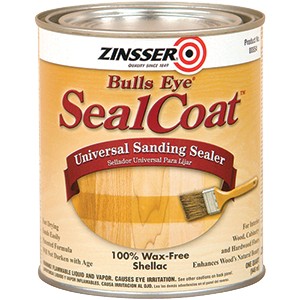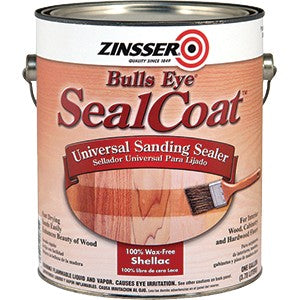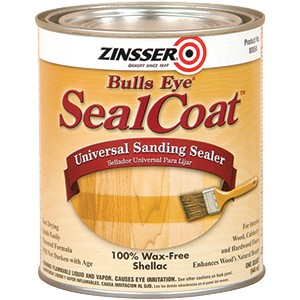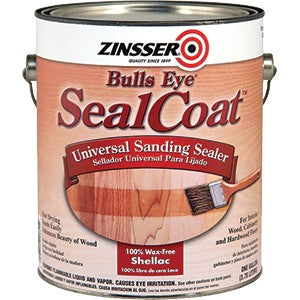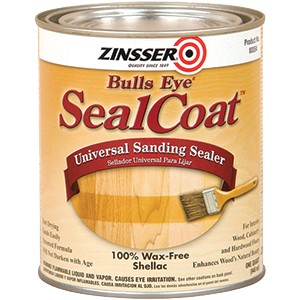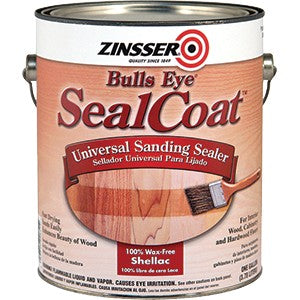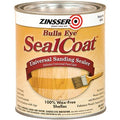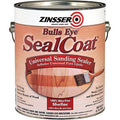interfere with adhesion. Remove any peeling and/or
unsound coatings. Sand bare wood as smoothly as
possible and remove all sanding dust. Previously applied
wood stains must be completely dry. Previously applied
finishes must be clean and tightly adhered.
WARNING!
If you scrape, sand or remove old paint, you
may release lead dust. LEAD IS TOXIC. EXPOSURE TO
LEAD DUST CAN CAUSE SERIOUS ILLNESS, SUCH AS
BRAIN DAMAGE, ESPECIALLY IN CHILDREN.
PREGNANT WOMEN SHOULD ALSO AVOID
EXPOSURE. Wear a NIOSH-Approved respirator to
control lead exposure. Clean up carefully with a HEPA
vacuum and a wet mop. Before you start, find out how to
protect yourself and your family by contacting the National
Lead Information Hotline at 1-800-424-LEAD or log on to
www.epa.gov/lead.
APPLICATION
Apply only when air, material, and surface temperatures
are between 50-90ºF (10-32ºC) and the relative humidity
is below 85%. Do not thin this product when using as a
sealer or bond/barrier coat. Apply evenly and consistently
and allow to dry 45 minutes before sanding with #120 or
finer grit sandpaper. Remove all dust and apply a finish
coat. Note: A second coat of sealer will improve the film
build and give added depth to the final finish on porous or
open grain woods such as oak or mahogany. Allow the
second coat to dry 1 hour before sanding lightly and
applying a finish coat.
Brush Application – For best results, use a natural bristle
brush. Apply the sealer to the surface using long and even
strokes, brushing back into the wet material to maintain a
wet edge. Do not over-brush or brush back into material
once it becomes tacky.
Wiping Application – Use a lint-free cloth. Pour a liberal
quantity of SealCoat onto the surface and quickly work
into the wood. Use a brush to make sure the sealer soaks
thoroughly into any open or end grain. Wipe away excess
with a lint-free cloth and stop wiping when the surface
becomes tacky. For vertical surfaces pour SealCoat onto a
lint-free cloth and wipe over the wood surface.
A second application may be needed to avoid sanding through the
sealer and the stain.
Spray Application – SealCoat may be sprayed using
conventional, HVLP, or airless spray. Use a 0.011 to 0.013
tip and 800-1000 psi for airless spray application.
Follow equipment manufacturer’s instructions.
Wear NIOSH approved respirator and provide adequate ventilation.
Doors/Trim/Paneling/Cabinets/Furniture – Apply 1 or 2
coats by wiping, brush or spray. Allow to dry completely
before sanding with #220 or finer grit sandpaper between
coats to ensure a smooth finish. If a heavier film build is
desired, repeat the application.Be sure to remove all
sanding dust before application of finish.
Floors – Floors should be properly sanded and free of
dust, dirt or other contaminants. Use a brush or floor finish
applicator and apply in the direction of the grain.
Apply the sealer on two or three board widths at a time, being sure
to keep a wet edge. Avoid over-applying or over-brushing.
Let dry for 45 minutes before sanding with #120 to #150
grit or finer sandpaper. Apply a second coat of sealer if
desired or an appropriate floor finish.
Pre-Stain Conditioner – SealCoat can be used to prevent
uneven stain penetration over soft woods such as pine.
Thin the product by adding 3 parts of denatured alcohol to
2 parts SealCoat. Apply with a brush or wipe on with a lint
-free cloth, working with the grain. Do not over apply or
recoat. After 15 minutes, lightly rub the surface with a fine
synthetic abrasion pad.
Bond Coat – SealCoat may be applied to an existing finish
to protect it from strong solvent-based coatings such as
lacquers. It can be used to ensure the adhesion of oil-
based polyurethane, water-based polyurethane, lacquer
and other clear finishes. Two full coats are required.
TINTING
Bulls-Eye SealCoat may be tinted with up to 2 ounces of
universal colorant per gallon. SealCoat may also be tinted
with alcohol-based stains or aniline dyes. Note that alcohol
stains will dilute the viscosity. If using powdered dyes,
shake to completely disperse the dye and let the
container sit to remove bubbles.
DRY TIME
Warmer temperatures will accelerate and colder
temperatures will prolong the dry time of this product. On
bare wood, the first coat will dry to the touch in 5-10 minutes
and can be sanded or recoated in 20-30 minutes.
Subsequent coats or coats applied over existing finishes
will dry to the touch in 10-15 minutes and can be sanded
or recoated in 1 hour. Lower temperatures, higher
humidity, and the addition of tint will prolong dry and cure
time. Allow more time at cooler temperatures.
SealCoat is not recommended for use in areas where surface heat
exceeds 160°F (71°C).
CLEAN-UP
Wipe up drips and spills with a rag soaked in denatured
alcohol or use a solution of household ammonia and
water. Clean brushes with denatured alcohol or
a solution of 1 part ammonia with 2 parts water. To dissolve
product that has dried on application tools, soak tools overnight in
an ammonia solution or denatured alcohol. Follow
equipment manufacturer’s directions to clean spray
equipment. Dispose of unused or unwanted product in
accordance with local, state and federal regulations.

